High-Performance Liquid Chromatography for Amino Acid Analysis
VerifiedAdded on 2023/01/16
|16
|5290
|61
Report
AI Summary
This laboratory report provides a detailed analysis of high-performance liquid chromatography (HPLC) as a method for measuring amino acids in plasma. The introduction highlights HPLC's advantages over traditional chromatography, emphasizing its ability to analyze trace concentrations and its widespread use in various scientific and industrial fields. The report explores different aspects of amino acid measurement using HPLC, including sample collection, preparation, and the significance of amino acid levels in diagnosing health problems. It then delves into various HPLC methodologies, such as partition, normal phase, displacement, reversed phase, size exclusion, and ion exchange chromatography, comparing their principles, applications, and advantages. The report also provides normal values of amino acids in children and adults. The conclusion summarizes the key findings and emphasizes the importance of HPLC in clinical and research settings for accurate amino acid quantification and its role in diagnosing various health conditions.

Laboratory Report
Paraphrase This Document
Need a fresh take? Get an instant paraphrase of this document with our AI Paraphraser

Table of Contents
INTRODUCTION...........................................................................................................................1
BODY..............................................................................................................................................2
What are the different aspects of measurement of amino acids in plasma using HPLC?...........2
Compare key HPLC methodologies............................................................................................4
CONCLUSION..............................................................................................................................11
REFERENCES..............................................................................................................................12
INTRODUCTION...........................................................................................................................1
BODY..............................................................................................................................................2
What are the different aspects of measurement of amino acids in plasma using HPLC?...........2
Compare key HPLC methodologies............................................................................................4
CONCLUSION..............................................................................................................................11
REFERENCES..............................................................................................................................12

⊘ This is a preview!⊘
Do you want full access?
Subscribe today to unlock all pages.

Trusted by 1+ million students worldwide
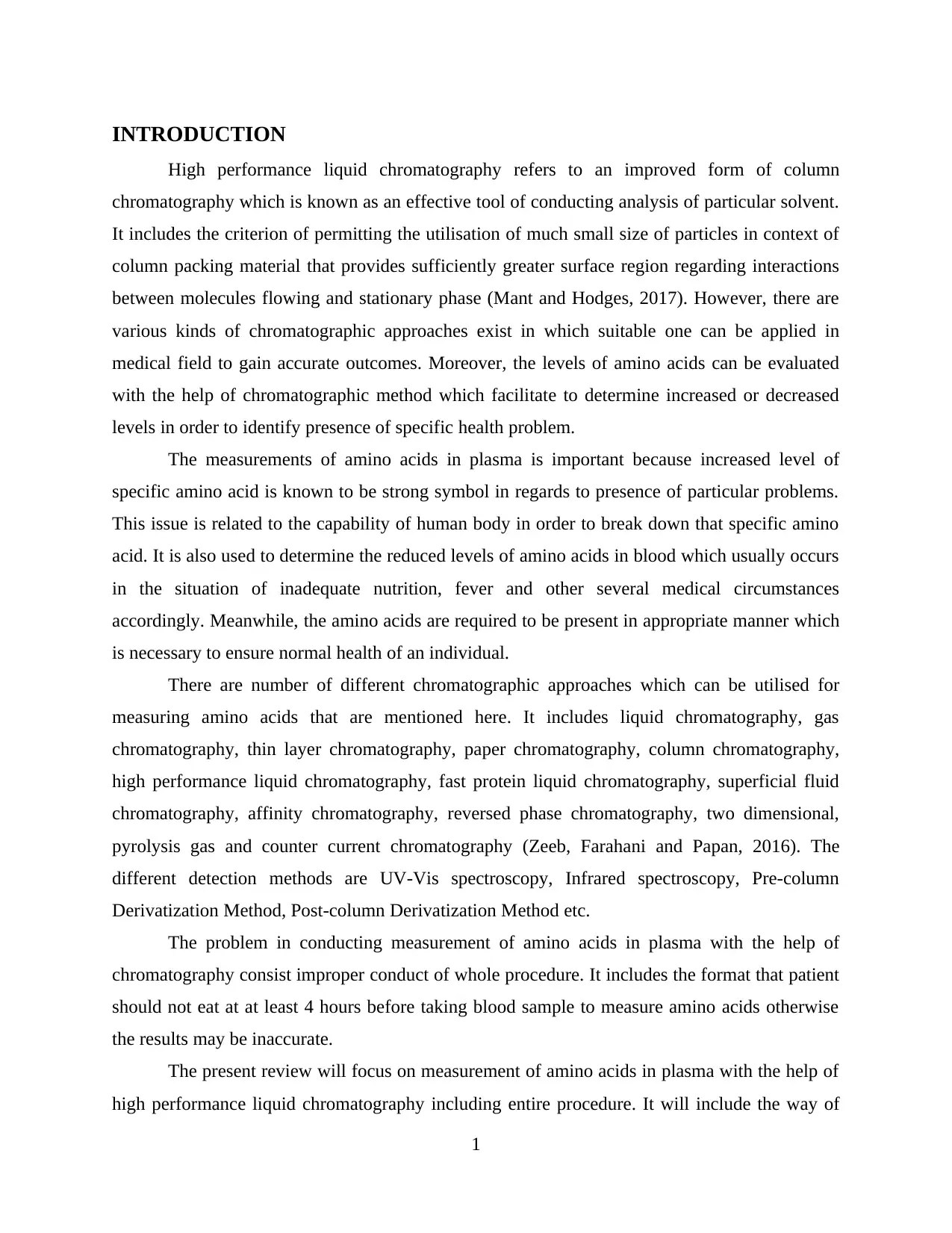
INTRODUCTION
High performance liquid chromatography refers to an improved form of column
chromatography which is known as an effective tool of conducting analysis of particular solvent.
It includes the criterion of permitting the utilisation of much small size of particles in context of
column packing material that provides sufficiently greater surface region regarding interactions
between molecules flowing and stationary phase (Mant and Hodges, 2017). However, there are
various kinds of chromatographic approaches exist in which suitable one can be applied in
medical field to gain accurate outcomes. Moreover, the levels of amino acids can be evaluated
with the help of chromatographic method which facilitate to determine increased or decreased
levels in order to identify presence of specific health problem.
The measurements of amino acids in plasma is important because increased level of
specific amino acid is known to be strong symbol in regards to presence of particular problems.
This issue is related to the capability of human body in order to break down that specific amino
acid. It is also used to determine the reduced levels of amino acids in blood which usually occurs
in the situation of inadequate nutrition, fever and other several medical circumstances
accordingly. Meanwhile, the amino acids are required to be present in appropriate manner which
is necessary to ensure normal health of an individual.
There are number of different chromatographic approaches which can be utilised for
measuring amino acids that are mentioned here. It includes liquid chromatography, gas
chromatography, thin layer chromatography, paper chromatography, column chromatography,
high performance liquid chromatography, fast protein liquid chromatography, superficial fluid
chromatography, affinity chromatography, reversed phase chromatography, two dimensional,
pyrolysis gas and counter current chromatography (Zeeb, Farahani and Papan, 2016). The
different detection methods are UV-Vis spectroscopy, Infrared spectroscopy, Pre-column
Derivatization Method, Post-column Derivatization Method etc.
The problem in conducting measurement of amino acids in plasma with the help of
chromatography consist improper conduct of whole procedure. It includes the format that patient
should not eat at at least 4 hours before taking blood sample to measure amino acids otherwise
the results may be inaccurate.
The present review will focus on measurement of amino acids in plasma with the help of
high performance liquid chromatography including entire procedure. It will include the way of
1
High performance liquid chromatography refers to an improved form of column
chromatography which is known as an effective tool of conducting analysis of particular solvent.
It includes the criterion of permitting the utilisation of much small size of particles in context of
column packing material that provides sufficiently greater surface region regarding interactions
between molecules flowing and stationary phase (Mant and Hodges, 2017). However, there are
various kinds of chromatographic approaches exist in which suitable one can be applied in
medical field to gain accurate outcomes. Moreover, the levels of amino acids can be evaluated
with the help of chromatographic method which facilitate to determine increased or decreased
levels in order to identify presence of specific health problem.
The measurements of amino acids in plasma is important because increased level of
specific amino acid is known to be strong symbol in regards to presence of particular problems.
This issue is related to the capability of human body in order to break down that specific amino
acid. It is also used to determine the reduced levels of amino acids in blood which usually occurs
in the situation of inadequate nutrition, fever and other several medical circumstances
accordingly. Meanwhile, the amino acids are required to be present in appropriate manner which
is necessary to ensure normal health of an individual.
There are number of different chromatographic approaches which can be utilised for
measuring amino acids that are mentioned here. It includes liquid chromatography, gas
chromatography, thin layer chromatography, paper chromatography, column chromatography,
high performance liquid chromatography, fast protein liquid chromatography, superficial fluid
chromatography, affinity chromatography, reversed phase chromatography, two dimensional,
pyrolysis gas and counter current chromatography (Zeeb, Farahani and Papan, 2016). The
different detection methods are UV-Vis spectroscopy, Infrared spectroscopy, Pre-column
Derivatization Method, Post-column Derivatization Method etc.
The problem in conducting measurement of amino acids in plasma with the help of
chromatography consist improper conduct of whole procedure. It includes the format that patient
should not eat at at least 4 hours before taking blood sample to measure amino acids otherwise
the results may be inaccurate.
The present review will focus on measurement of amino acids in plasma with the help of
high performance liquid chromatography including entire procedure. It will include the way of
1
Paraphrase This Document
Need a fresh take? Get an instant paraphrase of this document with our AI Paraphraser
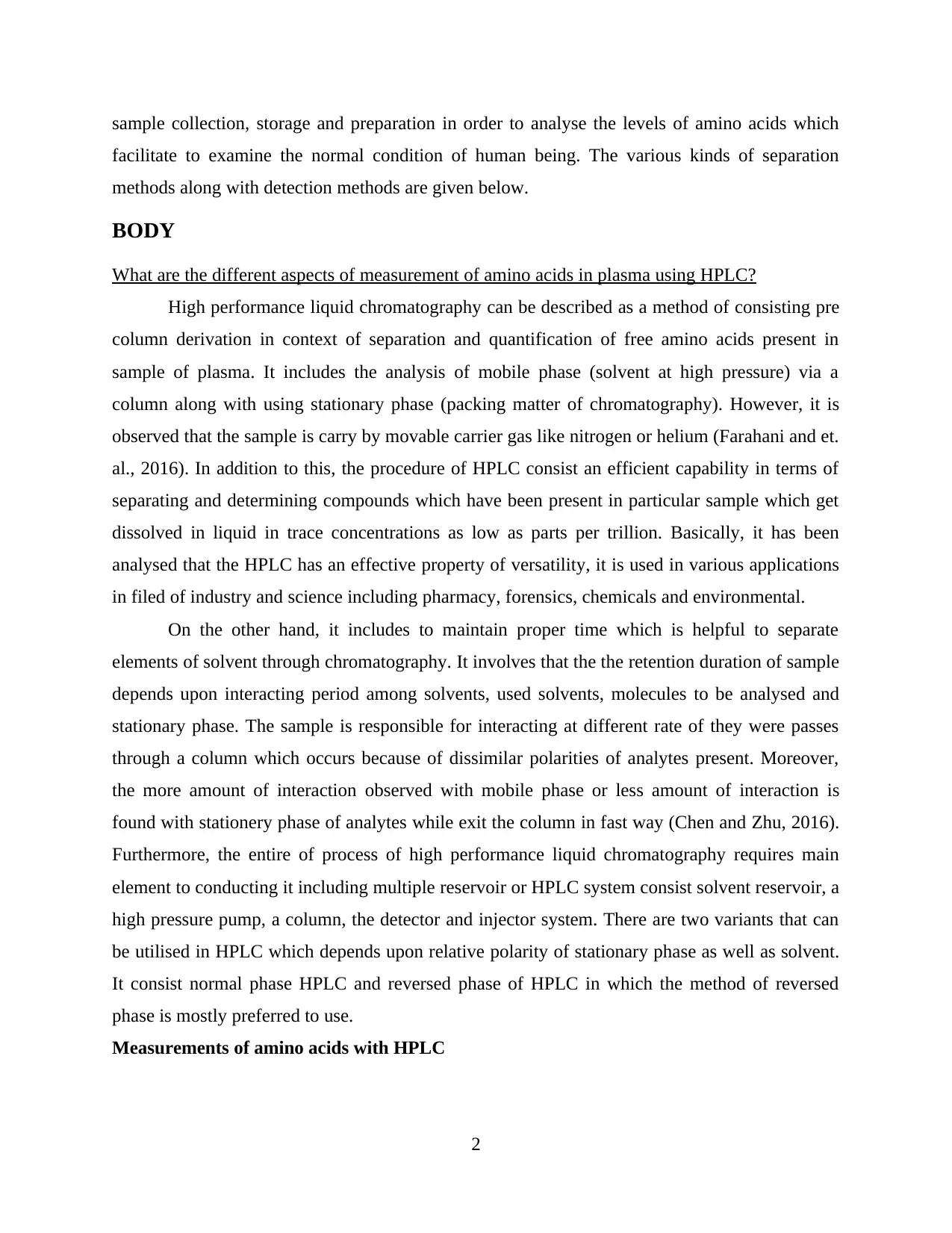
sample collection, storage and preparation in order to analyse the levels of amino acids which
facilitate to examine the normal condition of human being. The various kinds of separation
methods along with detection methods are given below.
BODY
What are the different aspects of measurement of amino acids in plasma using HPLC?
High performance liquid chromatography can be described as a method of consisting pre
column derivation in context of separation and quantification of free amino acids present in
sample of plasma. It includes the analysis of mobile phase (solvent at high pressure) via a
column along with using stationary phase (packing matter of chromatography). However, it is
observed that the sample is carry by movable carrier gas like nitrogen or helium (Farahani and et.
al., 2016). In addition to this, the procedure of HPLC consist an efficient capability in terms of
separating and determining compounds which have been present in particular sample which get
dissolved in liquid in trace concentrations as low as parts per trillion. Basically, it has been
analysed that the HPLC has an effective property of versatility, it is used in various applications
in filed of industry and science including pharmacy, forensics, chemicals and environmental.
On the other hand, it includes to maintain proper time which is helpful to separate
elements of solvent through chromatography. It involves that the the retention duration of sample
depends upon interacting period among solvents, used solvents, molecules to be analysed and
stationary phase. The sample is responsible for interacting at different rate of they were passes
through a column which occurs because of dissimilar polarities of analytes present. Moreover,
the more amount of interaction observed with mobile phase or less amount of interaction is
found with stationery phase of analytes while exit the column in fast way (Chen and Zhu, 2016).
Furthermore, the entire of process of high performance liquid chromatography requires main
element to conducting it including multiple reservoir or HPLC system consist solvent reservoir, a
high pressure pump, a column, the detector and injector system. There are two variants that can
be utilised in HPLC which depends upon relative polarity of stationary phase as well as solvent.
It consist normal phase HPLC and reversed phase of HPLC in which the method of reversed
phase is mostly preferred to use.
Measurements of amino acids with HPLC
2
facilitate to examine the normal condition of human being. The various kinds of separation
methods along with detection methods are given below.
BODY
What are the different aspects of measurement of amino acids in plasma using HPLC?
High performance liquid chromatography can be described as a method of consisting pre
column derivation in context of separation and quantification of free amino acids present in
sample of plasma. It includes the analysis of mobile phase (solvent at high pressure) via a
column along with using stationary phase (packing matter of chromatography). However, it is
observed that the sample is carry by movable carrier gas like nitrogen or helium (Farahani and et.
al., 2016). In addition to this, the procedure of HPLC consist an efficient capability in terms of
separating and determining compounds which have been present in particular sample which get
dissolved in liquid in trace concentrations as low as parts per trillion. Basically, it has been
analysed that the HPLC has an effective property of versatility, it is used in various applications
in filed of industry and science including pharmacy, forensics, chemicals and environmental.
On the other hand, it includes to maintain proper time which is helpful to separate
elements of solvent through chromatography. It involves that the the retention duration of sample
depends upon interacting period among solvents, used solvents, molecules to be analysed and
stationary phase. The sample is responsible for interacting at different rate of they were passes
through a column which occurs because of dissimilar polarities of analytes present. Moreover,
the more amount of interaction observed with mobile phase or less amount of interaction is
found with stationery phase of analytes while exit the column in fast way (Chen and Zhu, 2016).
Furthermore, the entire of process of high performance liquid chromatography requires main
element to conducting it including multiple reservoir or HPLC system consist solvent reservoir, a
high pressure pump, a column, the detector and injector system. There are two variants that can
be utilised in HPLC which depends upon relative polarity of stationary phase as well as solvent.
It consist normal phase HPLC and reversed phase of HPLC in which the method of reversed
phase is mostly preferred to use.
Measurements of amino acids with HPLC
2
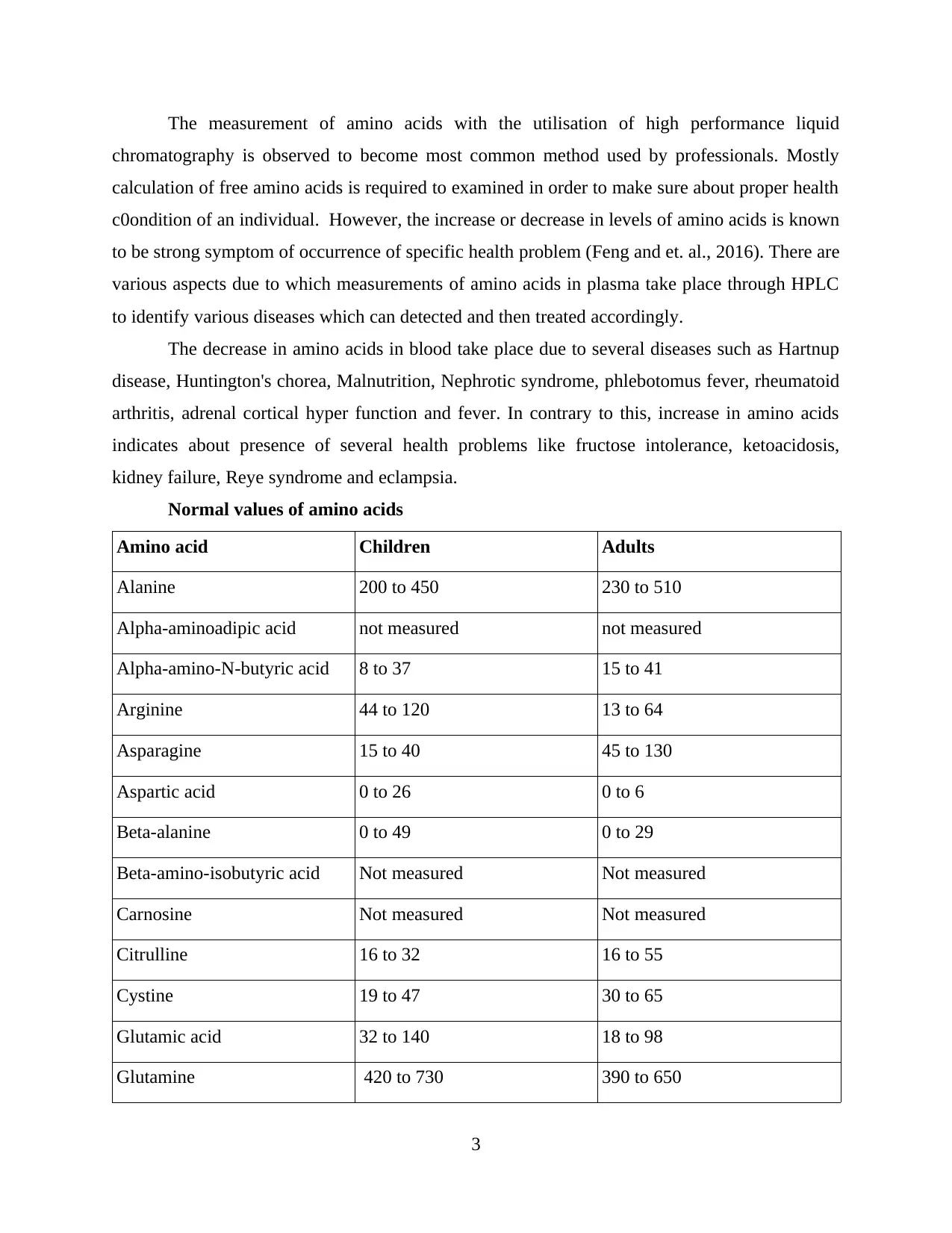
The measurement of amino acids with the utilisation of high performance liquid
chromatography is observed to become most common method used by professionals. Mostly
calculation of free amino acids is required to examined in order to make sure about proper health
c0ondition of an individual. However, the increase or decrease in levels of amino acids is known
to be strong symptom of occurrence of specific health problem (Feng and et. al., 2016). There are
various aspects due to which measurements of amino acids in plasma take place through HPLC
to identify various diseases which can detected and then treated accordingly.
The decrease in amino acids in blood take place due to several diseases such as Hartnup
disease, Huntington's chorea, Malnutrition, Nephrotic syndrome, phlebotomus fever, rheumatoid
arthritis, adrenal cortical hyper function and fever. In contrary to this, increase in amino acids
indicates about presence of several health problems like fructose intolerance, ketoacidosis,
kidney failure, Reye syndrome and eclampsia.
Normal values of amino acids
Amino acid Children Adults
Alanine 200 to 450 230 to 510
Alpha-aminoadipic acid not measured not measured
Alpha-amino-N-butyric acid 8 to 37 15 to 41
Arginine 44 to 120 13 to 64
Asparagine 15 to 40 45 to 130
Aspartic acid 0 to 26 0 to 6
Beta-alanine 0 to 49 0 to 29
Beta-amino-isobutyric acid Not measured Not measured
Carnosine Not measured Not measured
Citrulline 16 to 32 16 to 55
Cystine 19 to 47 30 to 65
Glutamic acid 32 to 140 18 to 98
Glutamine 420 to 730 390 to 650
3
chromatography is observed to become most common method used by professionals. Mostly
calculation of free amino acids is required to examined in order to make sure about proper health
c0ondition of an individual. However, the increase or decrease in levels of amino acids is known
to be strong symptom of occurrence of specific health problem (Feng and et. al., 2016). There are
various aspects due to which measurements of amino acids in plasma take place through HPLC
to identify various diseases which can detected and then treated accordingly.
The decrease in amino acids in blood take place due to several diseases such as Hartnup
disease, Huntington's chorea, Malnutrition, Nephrotic syndrome, phlebotomus fever, rheumatoid
arthritis, adrenal cortical hyper function and fever. In contrary to this, increase in amino acids
indicates about presence of several health problems like fructose intolerance, ketoacidosis,
kidney failure, Reye syndrome and eclampsia.
Normal values of amino acids
Amino acid Children Adults
Alanine 200 to 450 230 to 510
Alpha-aminoadipic acid not measured not measured
Alpha-amino-N-butyric acid 8 to 37 15 to 41
Arginine 44 to 120 13 to 64
Asparagine 15 to 40 45 to 130
Aspartic acid 0 to 26 0 to 6
Beta-alanine 0 to 49 0 to 29
Beta-amino-isobutyric acid Not measured Not measured
Carnosine Not measured Not measured
Citrulline 16 to 32 16 to 55
Cystine 19 to 47 30 to 65
Glutamic acid 32 to 140 18 to 98
Glutamine 420 to 730 390 to 650
3
⊘ This is a preview!⊘
Do you want full access?
Subscribe today to unlock all pages.

Trusted by 1+ million students worldwide
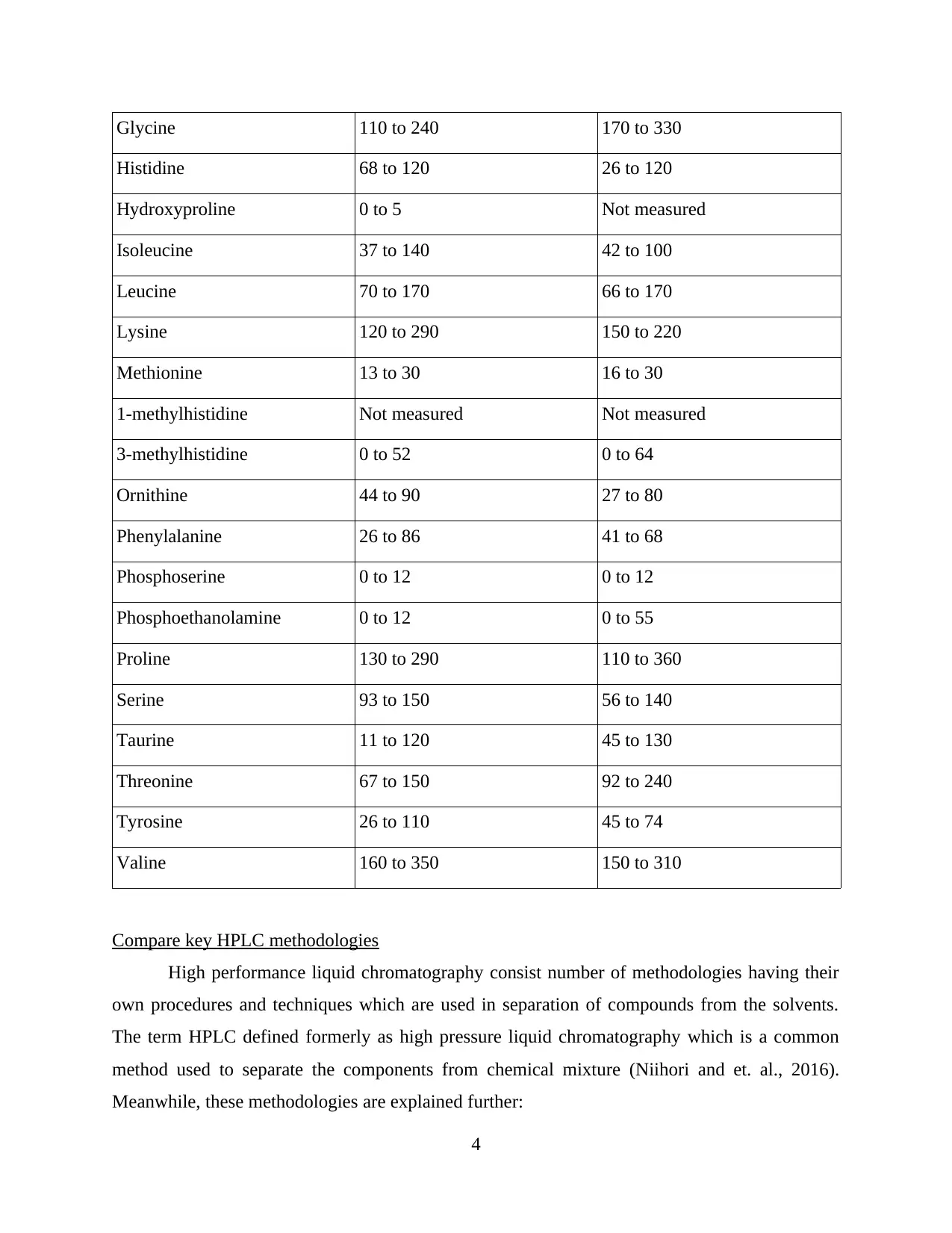
Glycine 110 to 240 170 to 330
Histidine 68 to 120 26 to 120
Hydroxyproline 0 to 5 Not measured
Isoleucine 37 to 140 42 to 100
Leucine 70 to 170 66 to 170
Lysine 120 to 290 150 to 220
Methionine 13 to 30 16 to 30
1-methylhistidine Not measured Not measured
3-methylhistidine 0 to 52 0 to 64
Ornithine 44 to 90 27 to 80
Phenylalanine 26 to 86 41 to 68
Phosphoserine 0 to 12 0 to 12
Phosphoethanolamine 0 to 12 0 to 55
Proline 130 to 290 110 to 360
Serine 93 to 150 56 to 140
Taurine 11 to 120 45 to 130
Threonine 67 to 150 92 to 240
Tyrosine 26 to 110 45 to 74
Valine 160 to 350 150 to 310
Compare key HPLC methodologies
High performance liquid chromatography consist number of methodologies having their
own procedures and techniques which are used in separation of compounds from the solvents.
The term HPLC defined formerly as high pressure liquid chromatography which is a common
method used to separate the components from chemical mixture (Niihori and et. al., 2016).
Meanwhile, these methodologies are explained further:
4
Histidine 68 to 120 26 to 120
Hydroxyproline 0 to 5 Not measured
Isoleucine 37 to 140 42 to 100
Leucine 70 to 170 66 to 170
Lysine 120 to 290 150 to 220
Methionine 13 to 30 16 to 30
1-methylhistidine Not measured Not measured
3-methylhistidine 0 to 52 0 to 64
Ornithine 44 to 90 27 to 80
Phenylalanine 26 to 86 41 to 68
Phosphoserine 0 to 12 0 to 12
Phosphoethanolamine 0 to 12 0 to 55
Proline 130 to 290 110 to 360
Serine 93 to 150 56 to 140
Taurine 11 to 120 45 to 130
Threonine 67 to 150 92 to 240
Tyrosine 26 to 110 45 to 74
Valine 160 to 350 150 to 310
Compare key HPLC methodologies
High performance liquid chromatography consist number of methodologies having their
own procedures and techniques which are used in separation of compounds from the solvents.
The term HPLC defined formerly as high pressure liquid chromatography which is a common
method used to separate the components from chemical mixture (Niihori and et. al., 2016).
Meanwhile, these methodologies are explained further:
4
Paraphrase This Document
Need a fresh take? Get an instant paraphrase of this document with our AI Paraphraser
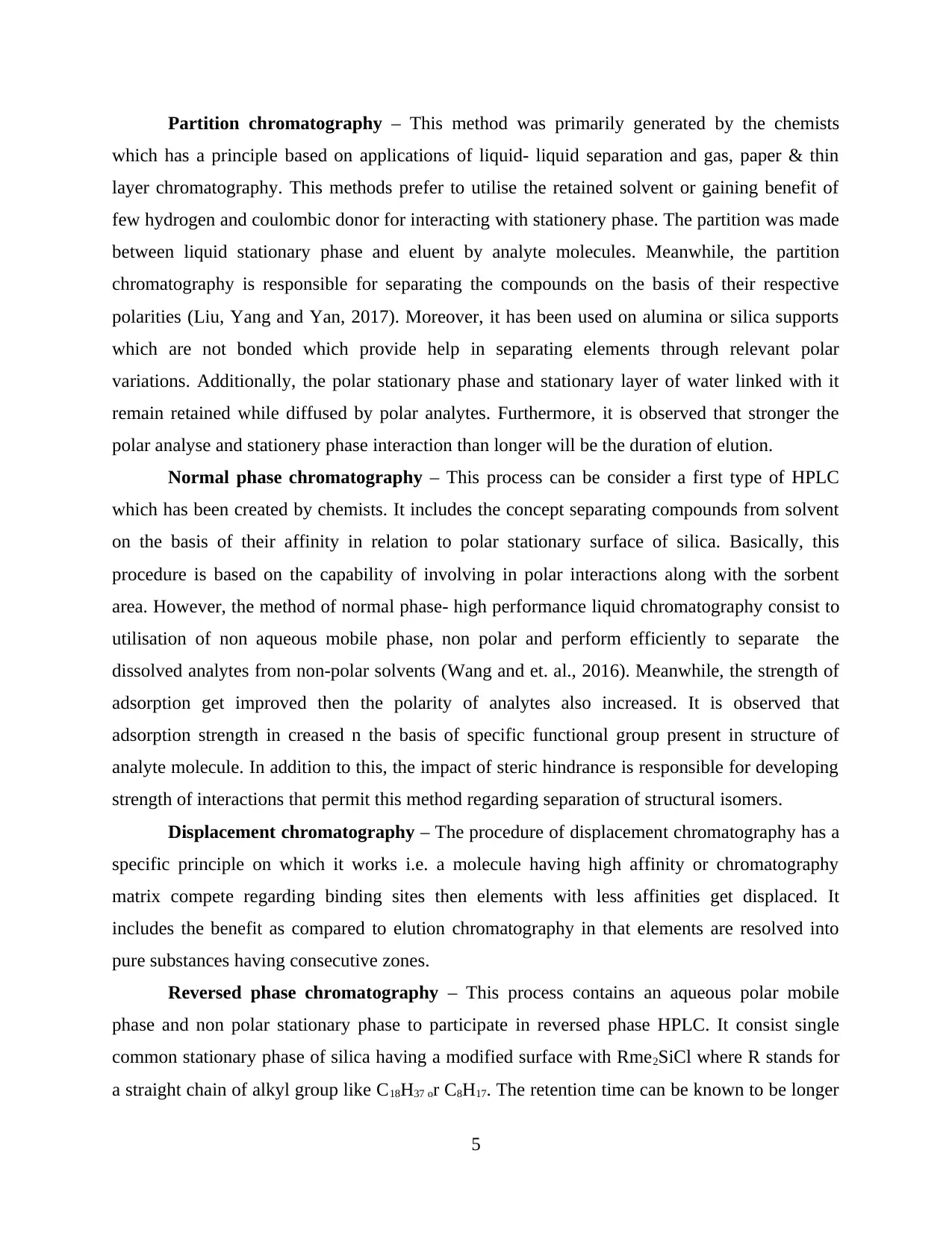
Partition chromatography – This method was primarily generated by the chemists
which has a principle based on applications of liquid- liquid separation and gas, paper & thin
layer chromatography. This methods prefer to utilise the retained solvent or gaining benefit of
few hydrogen and coulombic donor for interacting with stationery phase. The partition was made
between liquid stationary phase and eluent by analyte molecules. Meanwhile, the partition
chromatography is responsible for separating the compounds on the basis of their respective
polarities (Liu, Yang and Yan, 2017). Moreover, it has been used on alumina or silica supports
which are not bonded which provide help in separating elements through relevant polar
variations. Additionally, the polar stationary phase and stationary layer of water linked with it
remain retained while diffused by polar analytes. Furthermore, it is observed that stronger the
polar analyse and stationery phase interaction than longer will be the duration of elution.
Normal phase chromatography – This process can be consider a first type of HPLC
which has been created by chemists. It includes the concept separating compounds from solvent
on the basis of their affinity in relation to polar stationary surface of silica. Basically, this
procedure is based on the capability of involving in polar interactions along with the sorbent
area. However, the method of normal phase- high performance liquid chromatography consist to
utilisation of non aqueous mobile phase, non polar and perform efficiently to separate the
dissolved analytes from non-polar solvents (Wang and et. al., 2016). Meanwhile, the strength of
adsorption get improved then the polarity of analytes also increased. It is observed that
adsorption strength in creased n the basis of specific functional group present in structure of
analyte molecule. In addition to this, the impact of steric hindrance is responsible for developing
strength of interactions that permit this method regarding separation of structural isomers.
Displacement chromatography – The procedure of displacement chromatography has a
specific principle on which it works i.e. a molecule having high affinity or chromatography
matrix compete regarding binding sites then elements with less affinities get displaced. It
includes the benefit as compared to elution chromatography in that elements are resolved into
pure substances having consecutive zones.
Reversed phase chromatography – This process contains an aqueous polar mobile
phase and non polar stationary phase to participate in reversed phase HPLC. It consist single
common stationary phase of silica having a modified surface with Rme2SiCl where R stands for
a straight chain of alkyl group like C18H37 or C8H17. The retention time can be known to be longer
5
which has a principle based on applications of liquid- liquid separation and gas, paper & thin
layer chromatography. This methods prefer to utilise the retained solvent or gaining benefit of
few hydrogen and coulombic donor for interacting with stationery phase. The partition was made
between liquid stationary phase and eluent by analyte molecules. Meanwhile, the partition
chromatography is responsible for separating the compounds on the basis of their respective
polarities (Liu, Yang and Yan, 2017). Moreover, it has been used on alumina or silica supports
which are not bonded which provide help in separating elements through relevant polar
variations. Additionally, the polar stationary phase and stationary layer of water linked with it
remain retained while diffused by polar analytes. Furthermore, it is observed that stronger the
polar analyse and stationery phase interaction than longer will be the duration of elution.
Normal phase chromatography – This process can be consider a first type of HPLC
which has been created by chemists. It includes the concept separating compounds from solvent
on the basis of their affinity in relation to polar stationary surface of silica. Basically, this
procedure is based on the capability of involving in polar interactions along with the sorbent
area. However, the method of normal phase- high performance liquid chromatography consist to
utilisation of non aqueous mobile phase, non polar and perform efficiently to separate the
dissolved analytes from non-polar solvents (Wang and et. al., 2016). Meanwhile, the strength of
adsorption get improved then the polarity of analytes also increased. It is observed that
adsorption strength in creased n the basis of specific functional group present in structure of
analyte molecule. In addition to this, the impact of steric hindrance is responsible for developing
strength of interactions that permit this method regarding separation of structural isomers.
Displacement chromatography – The procedure of displacement chromatography has a
specific principle on which it works i.e. a molecule having high affinity or chromatography
matrix compete regarding binding sites then elements with less affinities get displaced. It
includes the benefit as compared to elution chromatography in that elements are resolved into
pure substances having consecutive zones.
Reversed phase chromatography – This process contains an aqueous polar mobile
phase and non polar stationary phase to participate in reversed phase HPLC. It consist single
common stationary phase of silica having a modified surface with Rme2SiCl where R stands for
a straight chain of alkyl group like C18H37 or C8H17. The retention time can be known to be longer
5
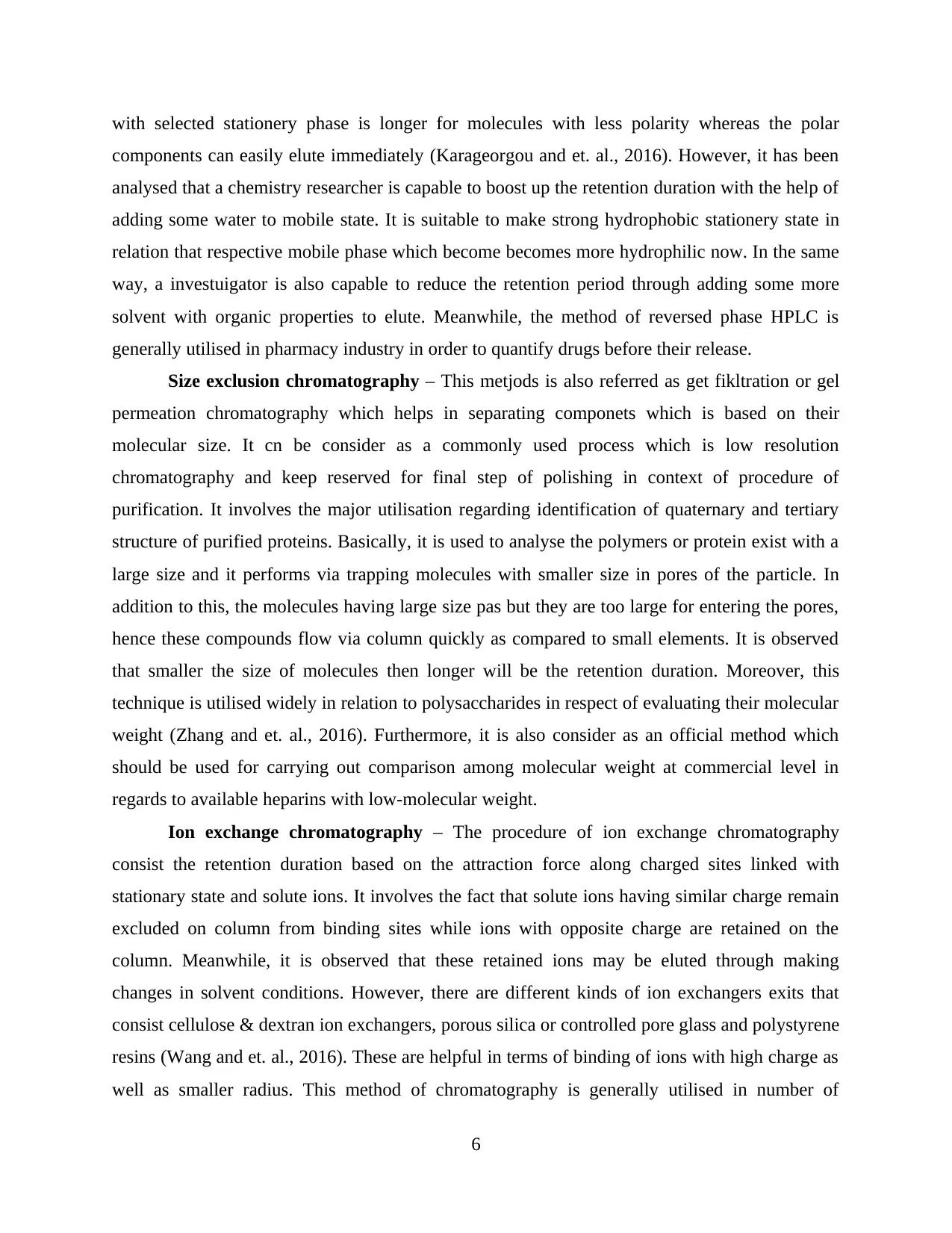
with selected stationery phase is longer for molecules with less polarity whereas the polar
components can easily elute immediately (Karageorgou and et. al., 2016). However, it has been
analysed that a chemistry researcher is capable to boost up the retention duration with the help of
adding some water to mobile state. It is suitable to make strong hydrophobic stationery state in
relation that respective mobile phase which become becomes more hydrophilic now. In the same
way, a investuigator is also capable to reduce the retention period through adding some more
solvent with organic properties to elute. Meanwhile, the method of reversed phase HPLC is
generally utilised in pharmacy industry in order to quantify drugs before their release.
Size exclusion chromatography – This metjods is also referred as get fikltration or gel
permeation chromatography which helps in separating componets which is based on their
molecular size. It cn be consider as a commonly used process which is low resolution
chromatography and keep reserved for final step of polishing in context of procedure of
purification. It involves the major utilisation regarding identification of quaternary and tertiary
structure of purified proteins. Basically, it is used to analyse the polymers or protein exist with a
large size and it performs via trapping molecules with smaller size in pores of the particle. In
addition to this, the molecules having large size pas but they are too large for entering the pores,
hence these compounds flow via column quickly as compared to small elements. It is observed
that smaller the size of molecules then longer will be the retention duration. Moreover, this
technique is utilised widely in relation to polysaccharides in respect of evaluating their molecular
weight (Zhang and et. al., 2016). Furthermore, it is also consider as an official method which
should be used for carrying out comparison among molecular weight at commercial level in
regards to available heparins with low-molecular weight.
Ion exchange chromatography – The procedure of ion exchange chromatography
consist the retention duration based on the attraction force along charged sites linked with
stationary state and solute ions. It involves the fact that solute ions having similar charge remain
excluded on column from binding sites while ions with opposite charge are retained on the
column. Meanwhile, it is observed that these retained ions may be eluted through making
changes in solvent conditions. However, there are different kinds of ion exchangers exits that
consist cellulose & dextran ion exchangers, porous silica or controlled pore glass and polystyrene
resins (Wang and et. al., 2016). These are helpful in terms of binding of ions with high charge as
well as smaller radius. This method of chromatography is generally utilised in number of
6
components can easily elute immediately (Karageorgou and et. al., 2016). However, it has been
analysed that a chemistry researcher is capable to boost up the retention duration with the help of
adding some water to mobile state. It is suitable to make strong hydrophobic stationery state in
relation that respective mobile phase which become becomes more hydrophilic now. In the same
way, a investuigator is also capable to reduce the retention period through adding some more
solvent with organic properties to elute. Meanwhile, the method of reversed phase HPLC is
generally utilised in pharmacy industry in order to quantify drugs before their release.
Size exclusion chromatography – This metjods is also referred as get fikltration or gel
permeation chromatography which helps in separating componets which is based on their
molecular size. It cn be consider as a commonly used process which is low resolution
chromatography and keep reserved for final step of polishing in context of procedure of
purification. It involves the major utilisation regarding identification of quaternary and tertiary
structure of purified proteins. Basically, it is used to analyse the polymers or protein exist with a
large size and it performs via trapping molecules with smaller size in pores of the particle. In
addition to this, the molecules having large size pas but they are too large for entering the pores,
hence these compounds flow via column quickly as compared to small elements. It is observed
that smaller the size of molecules then longer will be the retention duration. Moreover, this
technique is utilised widely in relation to polysaccharides in respect of evaluating their molecular
weight (Zhang and et. al., 2016). Furthermore, it is also consider as an official method which
should be used for carrying out comparison among molecular weight at commercial level in
regards to available heparins with low-molecular weight.
Ion exchange chromatography – The procedure of ion exchange chromatography
consist the retention duration based on the attraction force along charged sites linked with
stationary state and solute ions. It involves the fact that solute ions having similar charge remain
excluded on column from binding sites while ions with opposite charge are retained on the
column. Meanwhile, it is observed that these retained ions may be eluted through making
changes in solvent conditions. However, there are different kinds of ion exchangers exits that
consist cellulose & dextran ion exchangers, porous silica or controlled pore glass and polystyrene
resins (Wang and et. al., 2016). These are helpful in terms of binding of ions with high charge as
well as smaller radius. This method of chromatography is generally utilised in number of
6
⊘ This is a preview!⊘
Do you want full access?
Subscribe today to unlock all pages.

Trusted by 1+ million students worldwide
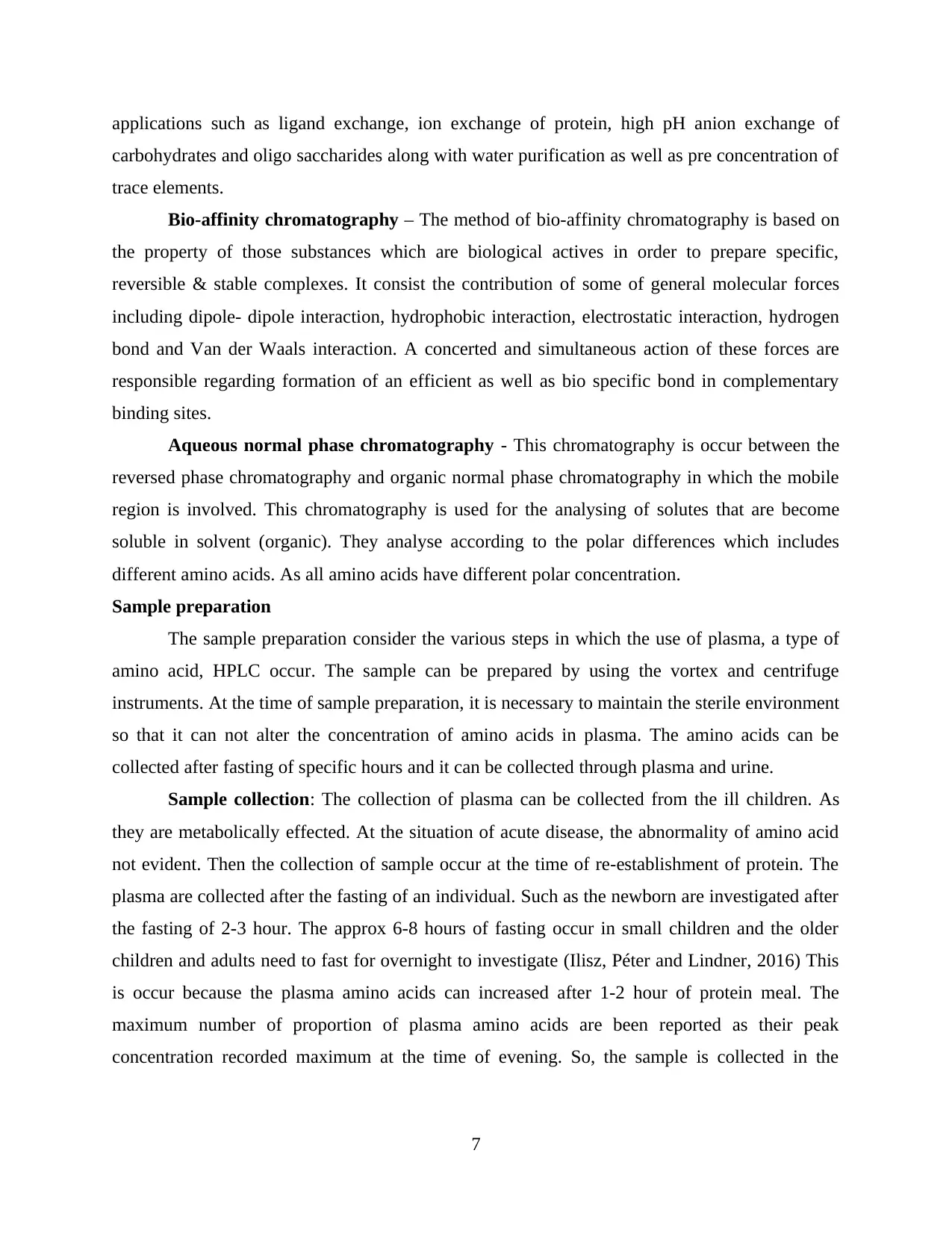
applications such as ligand exchange, ion exchange of protein, high pH anion exchange of
carbohydrates and oligo saccharides along with water purification as well as pre concentration of
trace elements.
Bio-affinity chromatography – The method of bio-affinity chromatography is based on
the property of those substances which are biological actives in order to prepare specific,
reversible & stable complexes. It consist the contribution of some of general molecular forces
including dipole- dipole interaction, hydrophobic interaction, electrostatic interaction, hydrogen
bond and Van der Waals interaction. A concerted and simultaneous action of these forces are
responsible regarding formation of an efficient as well as bio specific bond in complementary
binding sites.
Aqueous normal phase chromatography - This chromatography is occur between the
reversed phase chromatography and organic normal phase chromatography in which the mobile
region is involved. This chromatography is used for the analysing of solutes that are become
soluble in solvent (organic). They analyse according to the polar differences which includes
different amino acids. As all amino acids have different polar concentration.
Sample preparation
The sample preparation consider the various steps in which the use of plasma, a type of
amino acid, HPLC occur. The sample can be prepared by using the vortex and centrifuge
instruments. At the time of sample preparation, it is necessary to maintain the sterile environment
so that it can not alter the concentration of amino acids in plasma. The amino acids can be
collected after fasting of specific hours and it can be collected through plasma and urine.
Sample collection: The collection of plasma can be collected from the ill children. As
they are metabolically effected. At the situation of acute disease, the abnormality of amino acid
not evident. Then the collection of sample occur at the time of re-establishment of protein. The
plasma are collected after the fasting of an individual. Such as the newborn are investigated after
the fasting of 2-3 hour. The approx 6-8 hours of fasting occur in small children and the older
children and adults need to fast for overnight to investigate (Ilisz, Péter and Lindner, 2016) This
is occur because the plasma amino acids can increased after 1-2 hour of protein meal. The
maximum number of proportion of plasma amino acids are been reported as their peak
concentration recorded maximum at the time of evening. So, the sample is collected in the
7
carbohydrates and oligo saccharides along with water purification as well as pre concentration of
trace elements.
Bio-affinity chromatography – The method of bio-affinity chromatography is based on
the property of those substances which are biological actives in order to prepare specific,
reversible & stable complexes. It consist the contribution of some of general molecular forces
including dipole- dipole interaction, hydrophobic interaction, electrostatic interaction, hydrogen
bond and Van der Waals interaction. A concerted and simultaneous action of these forces are
responsible regarding formation of an efficient as well as bio specific bond in complementary
binding sites.
Aqueous normal phase chromatography - This chromatography is occur between the
reversed phase chromatography and organic normal phase chromatography in which the mobile
region is involved. This chromatography is used for the analysing of solutes that are become
soluble in solvent (organic). They analyse according to the polar differences which includes
different amino acids. As all amino acids have different polar concentration.
Sample preparation
The sample preparation consider the various steps in which the use of plasma, a type of
amino acid, HPLC occur. The sample can be prepared by using the vortex and centrifuge
instruments. At the time of sample preparation, it is necessary to maintain the sterile environment
so that it can not alter the concentration of amino acids in plasma. The amino acids can be
collected after fasting of specific hours and it can be collected through plasma and urine.
Sample collection: The collection of plasma can be collected from the ill children. As
they are metabolically effected. At the situation of acute disease, the abnormality of amino acid
not evident. Then the collection of sample occur at the time of re-establishment of protein. The
plasma are collected after the fasting of an individual. Such as the newborn are investigated after
the fasting of 2-3 hour. The approx 6-8 hours of fasting occur in small children and the older
children and adults need to fast for overnight to investigate (Ilisz, Péter and Lindner, 2016) This
is occur because the plasma amino acids can increased after 1-2 hour of protein meal. The
maximum number of proportion of plasma amino acids are been reported as their peak
concentration recorded maximum at the time of evening. So, the sample is collected in the
7
Paraphrase This Document
Need a fresh take? Get an instant paraphrase of this document with our AI Paraphraser
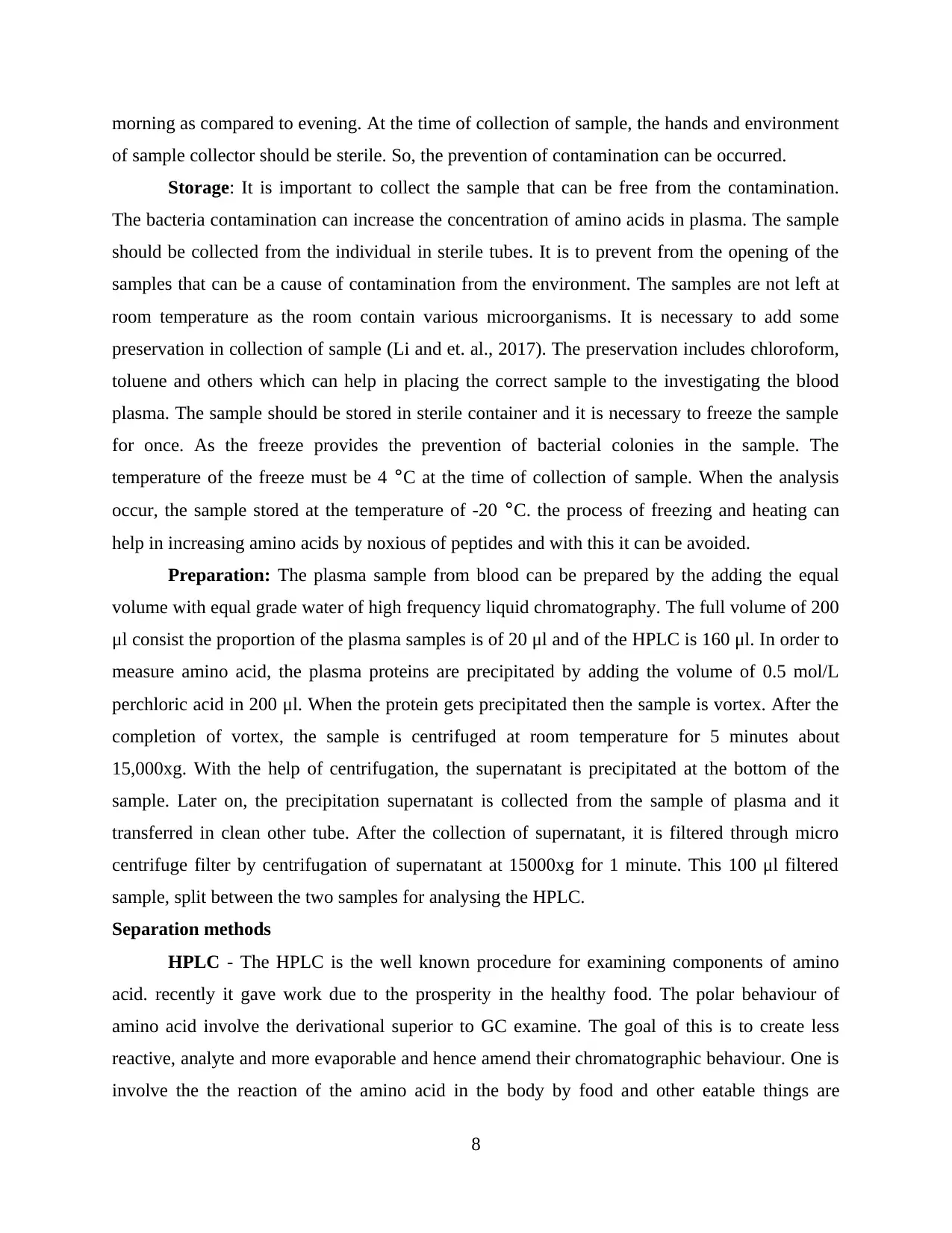
morning as compared to evening. At the time of collection of sample, the hands and environment
of sample collector should be sterile. So, the prevention of contamination can be occurred.
Storage: It is important to collect the sample that can be free from the contamination.
The bacteria contamination can increase the concentration of amino acids in plasma. The sample
should be collected from the individual in sterile tubes. It is to prevent from the opening of the
samples that can be a cause of contamination from the environment. The samples are not left at
room temperature as the room contain various microorganisms. It is necessary to add some
preservation in collection of sample (Li and et. al., 2017). The preservation includes chloroform,
toluene and others which can help in placing the correct sample to the investigating the blood
plasma. The sample should be stored in sterile container and it is necessary to freeze the sample
for once. As the freeze provides the prevention of bacterial colonies in the sample. The
temperature of the freeze must be 4 °C at the time of collection of sample. When the analysis
occur, the sample stored at the temperature of -20 °C. the process of freezing and heating can
help in increasing amino acids by noxious of peptides and with this it can be avoided.
Preparation: The plasma sample from blood can be prepared by the adding the equal
volume with equal grade water of high frequency liquid chromatography. The full volume of 200
μl consist the proportion of the plasma samples is of 20 μl and of the HPLC is 160 μl. In order to
measure amino acid, the plasma proteins are precipitated by adding the volume of 0.5 mol/L
perchloric acid in 200 μl. When the protein gets precipitated then the sample is vortex. After the
completion of vortex, the sample is centrifuged at room temperature for 5 minutes about
15,000xg. With the help of centrifugation, the supernatant is precipitated at the bottom of the
sample. Later on, the precipitation supernatant is collected from the sample of plasma and it
transferred in clean other tube. After the collection of supernatant, it is filtered through micro
centrifuge filter by centrifugation of supernatant at 15000xg for 1 minute. This 100 μl filtered
sample, split between the two samples for analysing the HPLC.
Separation methods
HPLC - The HPLC is the well known procedure for examining components of amino
acid. recently it gave work due to the prosperity in the healthy food. The polar behaviour of
amino acid involve the derivational superior to GC examine. The goal of this is to create less
reactive, analyte and more evaporable and hence amend their chromatographic behaviour. One is
involve the the reaction of the amino acid in the body by food and other eatable things are
8
of sample collector should be sterile. So, the prevention of contamination can be occurred.
Storage: It is important to collect the sample that can be free from the contamination.
The bacteria contamination can increase the concentration of amino acids in plasma. The sample
should be collected from the individual in sterile tubes. It is to prevent from the opening of the
samples that can be a cause of contamination from the environment. The samples are not left at
room temperature as the room contain various microorganisms. It is necessary to add some
preservation in collection of sample (Li and et. al., 2017). The preservation includes chloroform,
toluene and others which can help in placing the correct sample to the investigating the blood
plasma. The sample should be stored in sterile container and it is necessary to freeze the sample
for once. As the freeze provides the prevention of bacterial colonies in the sample. The
temperature of the freeze must be 4 °C at the time of collection of sample. When the analysis
occur, the sample stored at the temperature of -20 °C. the process of freezing and heating can
help in increasing amino acids by noxious of peptides and with this it can be avoided.
Preparation: The plasma sample from blood can be prepared by the adding the equal
volume with equal grade water of high frequency liquid chromatography. The full volume of 200
μl consist the proportion of the plasma samples is of 20 μl and of the HPLC is 160 μl. In order to
measure amino acid, the plasma proteins are precipitated by adding the volume of 0.5 mol/L
perchloric acid in 200 μl. When the protein gets precipitated then the sample is vortex. After the
completion of vortex, the sample is centrifuged at room temperature for 5 minutes about
15,000xg. With the help of centrifugation, the supernatant is precipitated at the bottom of the
sample. Later on, the precipitation supernatant is collected from the sample of plasma and it
transferred in clean other tube. After the collection of supernatant, it is filtered through micro
centrifuge filter by centrifugation of supernatant at 15000xg for 1 minute. This 100 μl filtered
sample, split between the two samples for analysing the HPLC.
Separation methods
HPLC - The HPLC is the well known procedure for examining components of amino
acid. recently it gave work due to the prosperity in the healthy food. The polar behaviour of
amino acid involve the derivational superior to GC examine. The goal of this is to create less
reactive, analyte and more evaporable and hence amend their chromatographic behaviour. One is
involve the the reaction of the amino acid in the body by food and other eatable things are
8
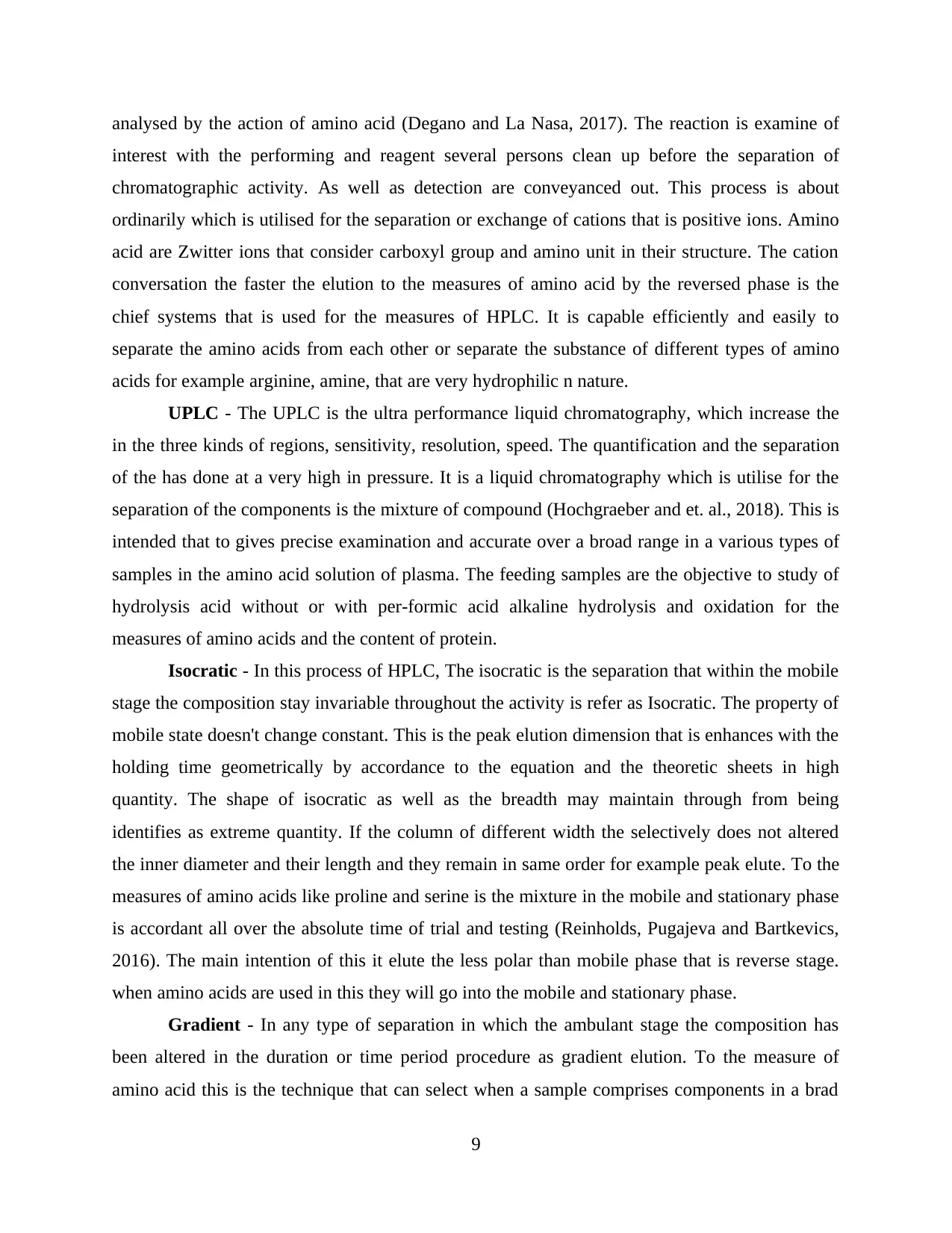
analysed by the action of amino acid (Degano and La Nasa, 2017). The reaction is examine of
interest with the performing and reagent several persons clean up before the separation of
chromatographic activity. As well as detection are conveyanced out. This process is about
ordinarily which is utilised for the separation or exchange of cations that is positive ions. Amino
acid are Zwitter ions that consider carboxyl group and amino unit in their structure. The cation
conversation the faster the elution to the measures of amino acid by the reversed phase is the
chief systems that is used for the measures of HPLC. It is capable efficiently and easily to
separate the amino acids from each other or separate the substance of different types of amino
acids for example arginine, amine, that are very hydrophilic n nature.
UPLC - The UPLC is the ultra performance liquid chromatography, which increase the
in the three kinds of regions, sensitivity, resolution, speed. The quantification and the separation
of the has done at a very high in pressure. It is a liquid chromatography which is utilise for the
separation of the components is the mixture of compound (Hochgraeber and et. al., 2018). This is
intended that to gives precise examination and accurate over a broad range in a various types of
samples in the amino acid solution of plasma. The feeding samples are the objective to study of
hydrolysis acid without or with per-formic acid alkaline hydrolysis and oxidation for the
measures of amino acids and the content of protein.
Isocratic - In this process of HPLC, The isocratic is the separation that within the mobile
stage the composition stay invariable throughout the activity is refer as Isocratic. The property of
mobile state doesn't change constant. This is the peak elution dimension that is enhances with the
holding time geometrically by accordance to the equation and the theoretic sheets in high
quantity. The shape of isocratic as well as the breadth may maintain through from being
identifies as extreme quantity. If the column of different width the selectively does not altered
the inner diameter and their length and they remain in same order for example peak elute. To the
measures of amino acids like proline and serine is the mixture in the mobile and stationary phase
is accordant all over the absolute time of trial and testing (Reinholds, Pugajeva and Bartkevics,
2016). The main intention of this it elute the less polar than mobile phase that is reverse stage.
when amino acids are used in this they will go into the mobile and stationary phase.
Gradient - In any type of separation in which the ambulant stage the composition has
been altered in the duration or time period procedure as gradient elution. To the measure of
amino acid this is the technique that can select when a sample comprises components in a brad
9
interest with the performing and reagent several persons clean up before the separation of
chromatographic activity. As well as detection are conveyanced out. This process is about
ordinarily which is utilised for the separation or exchange of cations that is positive ions. Amino
acid are Zwitter ions that consider carboxyl group and amino unit in their structure. The cation
conversation the faster the elution to the measures of amino acid by the reversed phase is the
chief systems that is used for the measures of HPLC. It is capable efficiently and easily to
separate the amino acids from each other or separate the substance of different types of amino
acids for example arginine, amine, that are very hydrophilic n nature.
UPLC - The UPLC is the ultra performance liquid chromatography, which increase the
in the three kinds of regions, sensitivity, resolution, speed. The quantification and the separation
of the has done at a very high in pressure. It is a liquid chromatography which is utilise for the
separation of the components is the mixture of compound (Hochgraeber and et. al., 2018). This is
intended that to gives precise examination and accurate over a broad range in a various types of
samples in the amino acid solution of plasma. The feeding samples are the objective to study of
hydrolysis acid without or with per-formic acid alkaline hydrolysis and oxidation for the
measures of amino acids and the content of protein.
Isocratic - In this process of HPLC, The isocratic is the separation that within the mobile
stage the composition stay invariable throughout the activity is refer as Isocratic. The property of
mobile state doesn't change constant. This is the peak elution dimension that is enhances with the
holding time geometrically by accordance to the equation and the theoretic sheets in high
quantity. The shape of isocratic as well as the breadth may maintain through from being
identifies as extreme quantity. If the column of different width the selectively does not altered
the inner diameter and their length and they remain in same order for example peak elute. To the
measures of amino acids like proline and serine is the mixture in the mobile and stationary phase
is accordant all over the absolute time of trial and testing (Reinholds, Pugajeva and Bartkevics,
2016). The main intention of this it elute the less polar than mobile phase that is reverse stage.
when amino acids are used in this they will go into the mobile and stationary phase.
Gradient - In any type of separation in which the ambulant stage the composition has
been altered in the duration or time period procedure as gradient elution. To the measure of
amino acid this is the technique that can select when a sample comprises components in a brad
9
⊘ This is a preview!⊘
Do you want full access?
Subscribe today to unlock all pages.

Trusted by 1+ million students worldwide
1 out of 16
Related Documents
Your All-in-One AI-Powered Toolkit for Academic Success.
+13062052269
info@desklib.com
Available 24*7 on WhatsApp / Email
![[object Object]](/_next/static/media/star-bottom.7253800d.svg)
Unlock your academic potential
Copyright © 2020–2025 A2Z Services. All Rights Reserved. Developed and managed by ZUCOL.





